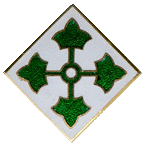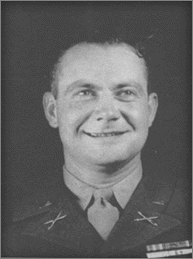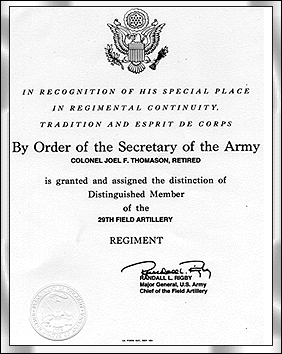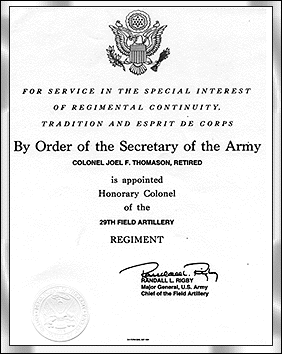

COL Joel F. Thomason
Battalion Commander
29th Field Artillery
World War II


Born December 26, 1917, in Lee County, Iowa, to John F. Thomason and Ethel M. Thomason. In August 1918, my family moved to
Rock Hill, South Carolina, where my father became a professor at Winthrop College (later Winthrop University).
I graduated from Winthrop Training School (affiliated with the college) in 1934, at the age 16, and was valedictorian of the class. I then
attended Furman University at Greenville, North Carolina from 1934-1935. In 1935, I was appointed to the United States Military Academy, West
Point, NY and graduated in 1939 as a 2nd Lieutenant, Field Artillery. While at West Point, I met Bernice Hartnett, and married in March 1940.
I then joined the 2nd Battalion, 83rd Field Artillery (horse drawn) at Fort Bragg, NC. In June, 1940, we moved to Fort Benning, GA, and I joined
the newly activated 4th Infantry Division. I was then transferred from the 83rd to the 1st Battalion, 29th Field Artillery (Bty C), in August 1940.
The unit was then redesignated as the 29th Field Artillery Battalion in October 1940. Reassigned from Fort Benning to Camp Gordon, GA, as the
Battalion S-3, and later as the Battalion Executive Officer during the Fall/Spring of 1941-1942. My son was born in January, 1941. I assumed
command of the 29th Field Artillery Battalion on September 1, 1942, at the age of 24, and was promoted to the rank of Lieutenant Colonel on June 12, 1944.
While at Camp Gordon, GA, the battalion became the "show" unit of the 4th Infantry Division, hosting all inspectors and many visitors from the War
Department, among others. The battalion excelled in firing artillery in all tests, had the best mess halls, best motor maintenance, and was the
best all around unit of the division. With stabilized personnel and concentrated training from 1941-1944, the division was, without a doubt, the
best trained division in the U.S. Army when it deployed to Europe in January, 1944.
The 29th Field Artillery arrived in Axminster, Devon, England in January 1944, and began extensive training. The amphibious training received in the
United States was repeated in England at Slapton Sands, during February- May 1944, culminating in the VII Corps Exercise TIGER. Also, during 1944, I
received news of the birth of my daughter.
As supporting artillery battalion for the 8th Infantry Regiment, the 29th FA Battalion was the first artillery unit to land in Normandy, at Utah Beach,
on D-Day, June 6, 1944. The battalion had the misfortune of losing a complete firing battery (the assault element of Battery B) to an enemy naval mine
about a mile offshore, on D-Day. A total 59 officers and men were casualties, with 39 being killed. Initial artillery support to the 8th Infantry
Regiment was accomplished with Batteries A and C, until Battery B was reformed in July 1944.
The battalion continued to support the 8th Infantry Regiment for the capture of Cherbourg, the breakthrough at St. Lo., the liberation of Paris and
Belgium, entry into Germany in September 1944, the Battle of the Bulge in December 1944, crossing the Rhine River in March 1945, and ending the war
in Bavaria in May 1945. The Division returned to the United States in July 1945, to prepare for the invasion of Japan, however, the war ended before
such invasion could occur.
The 29th FA Battalion was awarded a Presidential Unit citation for action on D-Day, and immediately thereafter by the War Department in General Order
No. 39, and I received my personal award of a Silver Star. However, my most treasured award came from an article written by Major General Harold
Blakeley a few months after the war, in which he cited me by name as the best Battalion Commander that he had ever known. General Blakeley was my
immediate superior from 1942 to 1945.
After the war, I served a two year tour in Puerto Rico, and a three year tour teaching Military History at West Point. I was then ordered to Korea in the
summer of 1952. After seven months on the east front with X Corps Artillery, I was assigned to the Eighth Army Headquarters for the final 5 months of
the war. I was then assigned to Japan, where my family joined me in October 1953. In May 1954, we returned to the United States for the Army War College.
Then followed tours in Washington DC, Fort Sill OK, and MAAG Belgium, where I retired in November 1966.
Shortly after WWII, I became very interested in the field of finance and investments, to the extent that I almost resigned from the Army. However, I decided
to continue to go on until I reached 26 years of service before my retirement. I did gain two post graduate courses in Investment Analysis, which I found
most helpful. I am still active in investments and have had considerable success.
Our son, Joel Jr., had two tours in combat in Vietnam from 1966-1969, but lost his life in an automobile accident in 1988. My wife and I moved into a retirement
community in northern Virginia, in 1989. She died in 1993, after 53 years of a wonderful marriage. I continue to enjoy life in northern Virgina, and I travel
extensively in both the United States and overseas.


I was the commander of the
29th Field Artillery Battalion which was the main fire support unit of the 8th Infantry
Regiment to which my unit was attached. I had taken command of the battalion during
the summer of 1942 when I was 24 years old. With concentrated training the batteries of
the battalion were ready for combat - -the officers and men were eager to go. There were
5 batteries in the battalion: Headquarters Battery, Service Battery and 3 firing batteries- -
A, B and C. The battalion with a 15% over strength to cover initial casualties, consisted
of about 700 men including 45 officers. The unit was equipped with self-propelled 105
mm howitzers, M-7s.
Our units were in the 4th Infantry Division which was organized at
Fort Benning, GA in 1940. The division had about 18,000 men and with several years
training prior to deployment to Europe was, without question, the best trained division in
the United States Army.The regiment was commanded by Colonel James A. Van Fleet. I
was on the command vesel with Colonel Van Fleet and our units were the initial assault
units of the 4th Infantry division making the amphibious landing on Utah Beach. Colonel
Van Fleet was a West Point classmate of Generals Eisenhower and Bradley- -class of
1915. General Van Fleet saved Greece from communism after WW II and later he
commanded the United Nations forces in Korea. He died in September 1992 at the age of
100 years.
We had loaded our units on various landing craft on the Dart River in
Dartmouth, England in late May. We sailed on he 4th of June with the intention of
making the landing on the 5th. However the weather was bad and the seas were high so
we pulled in behind the Isle of Wight when higher headquarters delayed the assault 24
hours.As the darkness gave way to early morning light, I could see a vast armada of boats
and ships of all types; it was an awe-inspiring sight. They were so numerous that it
appeared one could walk from England to France on them. The atmosphere was electric
with excitement and that was my feeling- - one of great excitement. This was the day for
which we had trained and awaited so long.
By 6:00 AM the battleship, cruisers and
destroyers were delivering their fire on the beach. The big guns of the battleship roared
and the 5 inch guns of the destroyers cracked. It was an impressive sight and we hoped
their fire would destroy the enemy strongpoints and make our landing easier. Airplanes
of the Army Air Corps with their new invasion markings were overhead throughout the
entire day. Of greatest importance, they had complete air superiority and quickly
destroyed or drove away the German aircraft which tried to intervene and get into the
action.
At about 7:00 AM Colonel Van Fleet and my small command party transferred to
smaller naval craft for the run into the beach. The initial waves of assault troops had
landed some 30 minutes earlier. As we approached the shore I studied the terrain;
nothing looked familiar. We had all memorized the photos which submarines had taken
earlier in the spring. That morning we could find nothing that looked like the photos. I
had a sinking feeling in my stomach; something was wrong.
The small landing craft
ground to a halt on a sand bar at what appeared to be a half mile from the shore. Had we
entered the water at that point we would have encountered depths well over our heads
before we reached the shore. We managed to get the naval officer to pull in closer so we
jumped into water about halfway up to our hips. Our individual equipment seemed to
weigh a ton; much of it we discarded shortly thereafter.
Enemy fire was falling on the
beach as we reached the shore’s edge. My first action was to sit down on the beach, light
a cigarette and pull out all my maps and photos. It was critical that we find out where we
were. With the other members of my party, we examined the terrain inland and compared
it with our maps and photos and finally determined our exact position. The navy had
landed us more than a mile south of our designated beaches. Therefore we had to adjust
our plans to conform to our actual location. It was a case of Clauswitz’s “Fog of
War”.
There was a strip of dunes and firm ground with some vegetation which extended
inland for several hundred yards from the water’s edge. Behind this was an inundated
area which could be crossed in places on foot but vehicles would have to use the
causeways. Initially we would have to find positions for the five assault elements of the
batteries among the dunes and move inland on the causway when permitted by the shore
party which controlled the beach. Of course we wanted to be off the beach as soon as
possible. We would not be able to fire our howitzers from our initial positions on the
beach because we did not know the location of the airborne units which had parachuted
inland during the darkness of the early morning hours.
My party was able to find fair
although crowded positions for the assault elements of the five batteries. They were
landed about 8:00 AM. It was then that I learned that the LCT-5 which was carrying
Battery B had been destroyed by a naval mine about a mile off shore. That was a great
tragedy. Of the 59 men on board, 39 were killed at the time. The remaining 20 were
severely wounded to the extent that only 3 or 4 were able to rejoin us many months later.
The battalion had lost one-third of its firepower before we even entered combat.
Our next task was to get the battalion off the beach where enemy fire was adding to the toll of our
already heavy casualties. I set out on foot with another officer to find firing battery
positions inland. By mid morning we had established contact with the airborne troops
and knowing the position of our own infantry, we were able to fire from our initial
position inland. During the afternoon we moved the battalion to a position south-east of
St. Mere Eglise and some seven or eight miles from the beach. There we fired some
missions throughout the afternoon and night in support of the three battalions of the 8th
Infantry. When darkness came at about 10:30 PM, we set up the harassing and
interdiction fires on suspected enemy locations and key road junctions. In our final
position a German sniper fired sporadic rounds into our command post but he never hit
anyone. A couple of paratroopers took care of the sniper.
At about midnight I lay down to
try to get some sleep. I was very tired, but my thoughts were of the many casualties we
had suffered during the day.Of the 28,000 men landed on Utah Beach on D-Day, the total
casualties were remarkably light- -just under 200. Unfortunately about one-third of that
number came from one small artillery battalion- - the 29th Field Artillery Battalion. For
the action on D-Day and immediately thereafter, the battalion was awarded a Presidential
Unit Citation, by War Department General Orders No. 39. I received a personal award of
the Silver Star.
BY
Joel F. Thomason
Colonel, US Army, Retired
April 30, 1994
Note: The officer that accompanied COL Thomason inland from the beach was CPT John C. Ausland, whose writings
are extensively covered in this web site. See "A Soldier Remembers Utah Beach" for more details on this harrowing walk inland from Utah Beach!
In 1997, COL Thomason received a letter from SSG Bernard J. Mayer, a man that served under him during World War II. This letter gives some measure of the great esteem
the men of the 29th Field Artillery held for their Battalion Commander, both during and after the war in Europe! Here, he expresses his memories, thoughts, and feelings
after nearly 52 years:
March 18, 1997
Dear Colonel Thomason;
I thought before I got too old to use this typewriter, am 80 years old now, I would drop you a line
and let you know that if I had to serve in the Army, I was very happy to serve with you. My name is
Ex S/Sgt. Bernard Mayer and served under Capt. James Hurst in Charley Btry. of the 29th.
I joined the 29th on D plus 3 along with Lt. Jack Cunningham who was in charge of the group of replacements
who landed on D plus 2 at St. Mere Eglise. We convoyed up to the front and picked out of the group by
Capt. Hurst to serve with him in Battery C. Lt. Bill Cole requested that I be his telephone lineman
and radio carrier. He made me jeep driver soon after and spent the next seven months up forward with
him, Cpl. Joe Gochenauer, and Pvt. Bill Martin. It was a good team and I was reluctant to leave when
Capt. Hurst made me his jeep and Command car driver when the snow hit and the roads got really bad.
Capt. Hurst knew I was from New Jersey with 10 years experience on snow and icy roads.
It was while driving for Capt. Hurst that I got to know and respect you for your wealth of knowledge, and judgement. I recall one recon in which you were in the lead jeep, followed by the Able, Baker, and then Capt. hurst, Cpl. Senerchia, and myself in the Charley jeep. Both your vehicle and Able made it up the side road and Baker jeep hit a mine just ahead of us killing the driver and the Officer lost both feet. I don't recall if he made it or not.See note below!
Another time on recon your jeep led as usual and we were following down the line in the C & R and the
shells started coming in from the right. We were narrowly missed by two 88 rounds that hit the high
dirt bank on our left, to the front. I could hear Cpl. Senerchia yell that he was hit and needed the
medics. It turned out it was hard dirt that came into the C & R and he was really only stung by the
impact. We were traveling at full speed by now and coming upon what looked like a huge cloud of smoke
or dust directly in our path. It was then I saw the gleam of the sun off your map case and hit the
brake very hard, sliding to a stop sideways in front of this gaping hole in the road. At the same time,
you leaped to safety to the right and escaped harm. You ordered me to leave the car blocking the road
in case other vehicles followed and we wnet down to where your jeep was and found a Major with a broken
leg. Cannot recall his name now, but knew him well from contact with your car. We put him in the Command
car and drove him to the aid station. Going back up that road seemed like an eternity and the lumbering
C & R just seemed to go ever so slow. Your calm attitude in this, was what got me through it.
I talked with Capt. Hurst in Florida on the phone just prior to his death, and the above was what he
talked about also along with many other he recalled. He seemed quite ill at the time, but I guess I
did not really know how ill he really was. He was a good man and I loved him dearly as the Battery
Commander. I am in contact with Lt. Bill Cole and Lt. Jack Cunningham and keep in touch by phone or
letter quite often. They both hold you in great esteem and are also proud to have served under you.
I was sorry to learn that your wife had died and you have my condolences for the loss of what they tell
me was a very lovely person. I know the anguish along with you, I lost my 21 year old son who was in
his last semester at Seton Hall College to Hodgekins disease in 1974.
Will close now with regards and hope you will enjoy many years of retirement in good health. Yours, signed Bernard J. Mayers
Note: The driver referred to above, CPL C.V. Sanders was killed instantly. The officer
was 2LT Otis Finnel.
The B Battery Commander, CPT Lorton S. "Doc" Livingston, despite being severely
injured himself, made
every effort to save him, but 2LT Finnel died several days later. "Doc" Livingston
eventually recovered
from his own grievous wounds. The incident happened on January 28, 1945.
The biography information was written by COL Joel F. Thomason, U.S. Army, Retired
Bernard Mayer's letter was provided by COL Thomason, and forwarded to us by Irving Smolens!
Our good friend Sandy Easton provided much graphics assistance!
Most Graphics Courtesy of Irving Smolens, with many thanks!
(with minor changes for continuity)